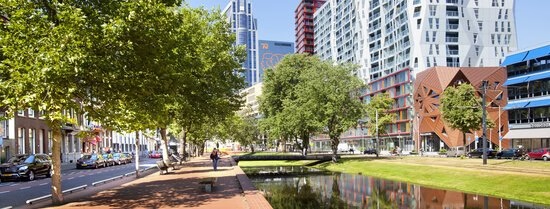Rotterdam is recognized worldwide as a city that excels at integrating and using nature, rather than defending against it. To celebrate this sustainable focus and perhaps inspire further action, we listed a number of initiatives that make Rotterdam a green and sustainable city.
The Rotterdam Climate Initiative and the Climate Change Adaptation Strategy
This was started in 2006, with the goal to reduce CO2 emissions by 50% by 2025. Reports have revealed that this plan is being implemented successfully and progress is constant. Next to that, Climate Change Adaptation is a strong concept used by Rotterdam and the strategy built around it aims to make Rotterdam climate proof by 2025. The focus areas for this to happen are infrastructure (especially water: dykes, barriers etc.), adopting nature-based approaches in designing the urban environment and linking climate adaptation measures to spatial development.
Heating from the industrial activities
The Port of Rotterdam is the largest in Europe and all the industrial activities that take place there produce an enormous amount of heat and one of the largest levels of CO2 in Europe and the world. To fight this issue, since 2012, this residual heat is no longer released into the environment, but used to provide warming for over 100,000 homes. The water passes through a 26 km long main pipeline, at over 120°C and circulates, diverging into smaller pipes and entering households at a much cooler 70°C. Even if this helps reduce CO2 emissions dramatically, investments in this area will continue, to ensure Rotterdam becomes the most sustainable port-city in the world.
Green-blue city
Rotterdam has a very strong connection with water and this is linked also with the climate adaptation plan. Canals and small ponds lead your way everywhere you go, along the tramlines or wide streets, but what most people don’t know is that for some of them, there are underground tanks and car parks that can store water in case of flood and release it gradually after the overflow passes. Blending in with the blue and helping the city absorb more water, there are always soothing green surface: trees, patches of grass and parks. They are not only useful for making the city flood-proof, but contribute to the liveability aspect and help keep the air clean.
Green rooftops
Maybe when you first step out of Rotterdam Central Station, the monumental scale of this impressive construction strikes you the most. Along with the modern towers and large buildings in Stationsplein and Weena, this makes up for a modern utopia. A green city is not very likely to pop up in your mind, as you set foot in Rotterdam for the first time. The truth is, however, that Rotterdam is working hard on the greening of the city, by increasing the amount of urban green public space and by including it in seemingly unexpected places. Greening of the tramlines makes for a nice view, but the best has to be the amount of green rooftops this city has (some 160,000 m2).
One remarkable construction that adds to this is The DakPark or Rooftop Park. It is the largest in Europe and measures 1200 m in length. Fully functional, it’s a great place to hang out in summer, but it has been shaped to also serve as a dyke, in case of flooding.
Involving citizens
One of the most important parts in all these plans is the population. Rotterdam is doing pretty well at involving its citizens and stimulating participation. At the same time, the municipality is also consulting the people and conducting research on citizens’ perception of and commitment to sustainability. On the practical side, there are subsidies for growing your own green roof and plenty of opportunities to have your patch of urban farm, somewhere in the city or to contribute to creating green spaces in your neighbourhood. Moreover, there are countless festivals and events that emphasize and make use of the urban green and blue.
All these large-scale initiatives are taking Rotterdam further on its way to becoming one the most sustainable cities in the world. Ultimately, change is in everyone and everything we do. It can start with sustainable choices, such as car sharing or biking, growing your own garden, being mindful of energy consumption, to recycling, returning empty batteries, bringing your own canvas bag for shopping or groceries, buying just enough, to prevent food waste and avoiding exotic purchases that might come from endangered species or that are obtained by damaging the environment. Nevertheless, it remains important to keep actively participating in the decision making process and to stay aware of how local and global leaders and businesses are serving this cause.
- More information
Photo credit: 500Watt

